
The weather has finally started to get nice here, and, honestly, I always feel like Scrappy in Dr. Bluebird watching the nice weather when I need to get various projects done, and there’s a lot of them right now. A bunch of the ‘special’ sets have been finished in the last few weeks, and more finishing up progress, along with many of the ‘official’ sets. My hands are very full, but fortunately the backup forces are starting again to get things out the door and all finished. Cartoons Paradise is almost done dubbing and we’re working on combining these pre-orders all together, along with the long awaited Screen Songs special set. Thanks to everyone for supporting these projects.
Since there’s so much interest, I’m making Screen Songs available through the Blu-ray.com forums for a little while. Details are here.
Now, onto part two of last week’s post:
The Flip’s have been an interesting task to make look nice. Some of the materials are in absolutely beautiful shape, while others need lots of work. Happily, most everything looks pretty decent as its getting finished, and that has a lot to do with my great group of freelance digital cleanup and restoration help.
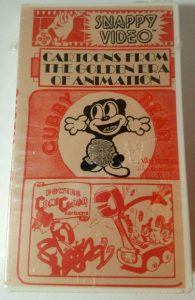 When I started Snappy Video back in the late 80s, I was incredibly lucky to find a handful of advisers to give me a very brief introduction to the world of telecine transfers. Jeff Missinne was probably the most helpful person early on, listening to some teenager blabbing about how good he wanted to make VHS sets while still in high school! 1986 was a pivotal year in my personal figuring out the basics of how to do sets. I was able to get the first scans done for the sets in 1987, borrowing some money from my parents to have a group of reel scanned. The $150 an hour of film seemed really steep at the time, but then again, I was just out of high school earning $3.35 an hour while working two jobs over that summer. I had already figured out that I could get a cleaner transfer of these films by having Vitafilm or a similar cleaner on them, so I had everything wiped with cleaner when I turned the prints in to be scanned, only to have the folks at Filmcraft labs inform me that they had to clean all the films before they were ‘wet-gated’ on their Rank Cintel scanner! It must have been difficult for them to deal with this little teenager who didn’t really know much about what it took to put sets together technically.
When I started Snappy Video back in the late 80s, I was incredibly lucky to find a handful of advisers to give me a very brief introduction to the world of telecine transfers. Jeff Missinne was probably the most helpful person early on, listening to some teenager blabbing about how good he wanted to make VHS sets while still in high school! 1986 was a pivotal year in my personal figuring out the basics of how to do sets. I was able to get the first scans done for the sets in 1987, borrowing some money from my parents to have a group of reel scanned. The $150 an hour of film seemed really steep at the time, but then again, I was just out of high school earning $3.35 an hour while working two jobs over that summer. I had already figured out that I could get a cleaner transfer of these films by having Vitafilm or a similar cleaner on them, so I had everything wiped with cleaner when I turned the prints in to be scanned, only to have the folks at Filmcraft labs inform me that they had to clean all the films before they were ‘wet-gated’ on their Rank Cintel scanner! It must have been difficult for them to deal with this little teenager who didn’t really know much about what it took to put sets together technically.
I managed to get a job at the University of Michigan Film and Video library late that summer, inspecting 16mm prints. Later, I would work full time there as the ‘Senior Film Inspector’ for the better part of my early 20s. I bugged the heck out of the University of Michigan Television technical staff, housed in the same building. They gave me all sorts of advice on tape, sound and editing systems at the time. All these years later, I still sort of miss the analogue aspects of editing.
At one of the first Cinevents I attended, someone showed me a tape of a digital restoration process that was being used for Hollywood features. It was a piece of hardware that would find the defects in each frame, replacing them with details from the frame before and after. It was being done for preparation to colorize films. It seemed to be a non-adjustable, automatic process, but yielded incredible results. I watched the VHS tape with disbelief, and wondered if there was any way for me to afford to do this, ever.
Here is a story showing the colorizing process back then, in the mid to late 80s:
All of these years later, I’m happy to say we’ve been cleaning films up digitally for a decade, starting with some very simple tools and graduating to more professional grade ones. The first program we got (in 2008) was a plug-in for Apple’s Final Cut Pro called ‘Film Fix’. It could remove dust, dirt and scratches pretty well from film, but was barely adjustable, and there was no way to ‘undo’ the over fixing that would happen while trying to clean up films. This overfill included erasing lines around the characters as well as other background details. Worse, the program would crash over and over again. I figured out I could process about a minute and a half of standard definition video at a time without crashing. I would then take the cleaned up footage into Adobe’s After Effects, sandwiching the original footage under the cleaned up footage, and erase back to the original where it over-cleaned things. This process was used for almost all the Thunderbean titles in standard def in from 2010 through 2013.
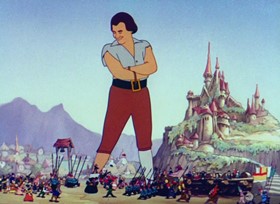 Our jump into HD is largely the fault of a few people. Our own Jerry Beck was trying to find a decent copy of Gulliver’s Travels for broadcast, and this sent me on a search to find a good print. Happily, several prints became available in the collector’s market, and we managed to scan then, but too late for the broadcast. Happily, the ‘Golden Age Cartoons forum’ members had already been great supporters of the Thunderbean sets, and they contributed to the scans of the Gulliver material.
Our jump into HD is largely the fault of a few people. Our own Jerry Beck was trying to find a decent copy of Gulliver’s Travels for broadcast, and this sent me on a search to find a good print. Happily, several prints became available in the collector’s market, and we managed to scan then, but too late for the broadcast. Happily, the ‘Golden Age Cartoons forum’ members had already been great supporters of the Thunderbean sets, and they contributed to the scans of the Gulliver material.
In 2013, at the Columbus Cinevent, I showed the scan to my friend Stewart McKissick and John McElwee (of the essential blog Greenbriar Picture Shows). Both were enthusiastic about the results, and suggested I pursue preparing the film for Blu-ray. At this point, I didn’t even own a Blu-ray player, but was excited to see what could be done. Later that same day, McElwee generously offered to contribute to the costs of producing the sets, providing the much needed funds to acquire a one-year lease on restoration software. One the better part of 2013, I worked on cleaning up Gulliver, almost entirely by myself, figuring out the best format, output, color grading for HD, rescanning pieces and finding both the features and limitations of various restoration software suites. After finishing this project, it was clear that we needed to continue using these kinds of tools on all future releases.
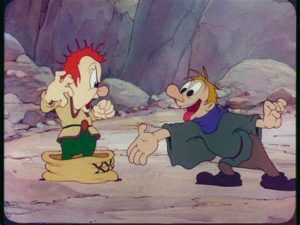 The word ‘restoration’ is both accurate and misleading in some ways. The tools for all the suites I’ve used do a great job cleaning top footage, but, unless you’re working in the full resolution of the original material, I feel (as others) that a full ‘restoration’ of the material isn’t happening. On many of the films, we have been able to work at the full resolution of the image, so these cleanups could go back to a film negative.
The word ‘restoration’ is both accurate and misleading in some ways. The tools for all the suites I’ve used do a great job cleaning top footage, but, unless you’re working in the full resolution of the original material, I feel (as others) that a full ‘restoration’ of the material isn’t happening. On many of the films, we have been able to work at the full resolution of the image, so these cleanups could go back to a film negative.
The professional ‘restoration’ digital tools are still expensive these days since it’s such a niche area of work, but I’ve been lucky enough to be able to afford a handful of licenses to spread the work around to a handful of freelancers. I’ve had quite a few people work directly with me at the Thunderbean Studio as well as working by themselves. I’ve found that the best people to clean up animation for these sets have a background in film or animation, or are great fans on the material and *want* to make sure they look great. This particular attention to detail, with them as well as here, allows a production pipeline that would be hard to duplicate at a larger studio in a cost-effective way. I have a great luxury with Thunderbean in being able to make sure everything is the best I can get it. Still, I look back at the finished ones and wish I had done this or that to make particular films just a little better.
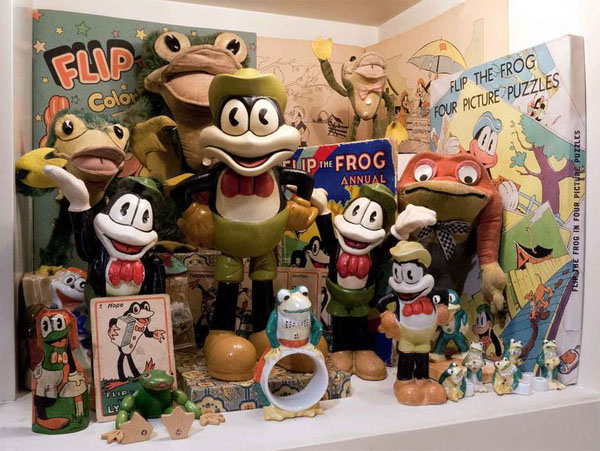
The current team on ‘Flip the Frog’ is an excellent group who really cares about the shorts. David Grauman is one of my usual suspects in this process. He’s a great detail person and excellent at making sure the films look as good as possible. Animation History expert and Cartoon Research contributing writer Thad Komorowski is, among his other talents, one of the best digital restoration artists I’ve worked with, often fixing things that I was already happy with on his cleanups of the Flip materials. He continues to contribute work to this set as well as others for Thunderbean and other companies. Both were excellent in contributing to the on the Willie Whopper project, In this past year, Animation History expert and contributing writer Devon Baxter also joined the team this year, contributing to both this project as well as the Rainbow Parade cartoons.
The basic process of cleaning this films up starts with the scans. We try, whenever possible, to wet gate the materials and to personally supervise the scans. Having a cleaner liquid on the film helps to hide abrasions as well as helping to clean off dust and dirt. Its important to be careful of the film in this process since materials can be brittle, especially in torn sprocket holds and old cement splices. Newer technology (including the excellent Laser Graphics Scan Station) has allowed an even more precise ability to can the surface of the film at the needed exact ‘level’ that avoids the light refraction caused by the scratches.
After scanning, the digital material is either single image files or compiled quicktime movie files. These are them brought into a program that allows digital cleanup, then often into a specific film/ digital restoration program. Adobe After Effects or Premiere are often the first to do some processing, from editing several versions of a film together steadying the image scene by scene and other work. Each stage is important to get right, since anything you do to the film will affect the final version.
When working on the films in a digital restoration program, the process often involves automatic passes in cleanup, followed by a frame by frame manual pass to ‘unfix’ the overfixes, followed by another pass or two to manually clean things the automatic pass didn’t. Depending on the film, this process really takes an experienced eye in deciding what process should be involved next, and sometimes it’s trial and error to make sure what you did was the most effective.
The final stage of the process includes editing in the sound, any titles to fix or replace, color correction, cropping and framing, and any other required work. Often several elements are compared to see what looks best, and sometimes additional materials are brought in, even at this stage, to make a version a little better. Of course, it’s always best if you can work from a single element to get the final result, but on the Flip the Frog set, many require at least a few elements to complete the film.
 One of the biggest heartbreaks on the project has been thinking we had found the color material on several other Flips. Sadly, *all* have turned out to be B/W tinted versions of the shorts rather than the Harris Color originals (like Fiddlesticks). I have the feeling that Fiddlesticks only exists in color because an edited together master was sent from England to Iwerks to make a Black and White master. None of the Flip’s appear to have been released in color in the United States.
One of the biggest heartbreaks on the project has been thinking we had found the color material on several other Flips. Sadly, *all* have turned out to be B/W tinted versions of the shorts rather than the Harris Color originals (like Fiddlesticks). I have the feeling that Fiddlesticks only exists in color because an edited together master was sent from England to Iwerks to make a Black and White master. None of the Flip’s appear to have been released in color in the United States.
Flying Fists, the second of the Flips, seems to only exist in black and white. Both masters at UCLA in 35mm were pretty beat up on this title. Thad took this particular work on and did an excellent job. To show you what he was up against, I’ve included here the opening scenes from these two masters, followed by the combination of these elements on the new cleaned up version. We both agreed this was the hardest of the series to clean up. I’ve included a few other clips here in the original element and the cleanup as examples as well. Note: this isn’t *quite* the final version of the footage; there is another pass beyond this to fix a few small problems, as is frequent when working on these films!
So many of these films look really excellent, and the team effort on this particular set is perhaps the biggest. The team effort to fully realize this set (so far!) includes David Shepard, Serge Bromberg, David Gerstein, Mark Kausler, Thad Komorowski, David Grauman, Devon Baxter, UCLA archives, Sami Kerwin, Lauren Schmidt, Mary Dixon, Jerry Beck and others. I’m very grateful to have a great team behind this project.
Have a good week everyone!
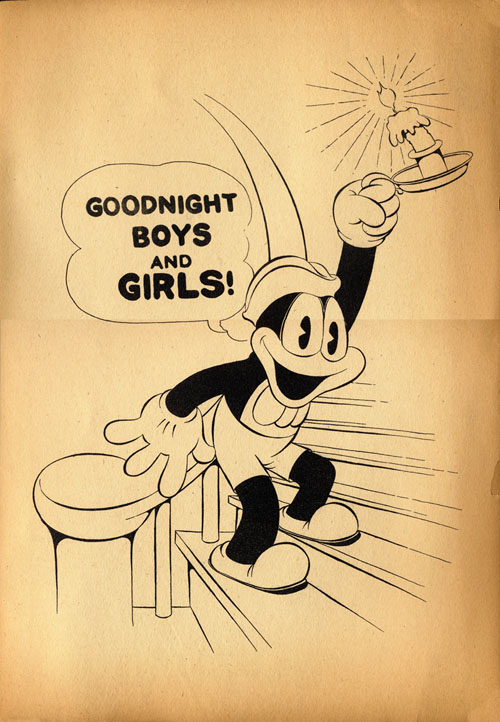


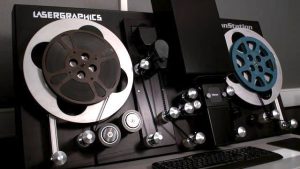
 Steve Stanchfield is an animator, educator and film archivist. He runs Thunderbean Animation, an animation studio in Ann Arbor, Michigan and has compiled over a dozen archival animation DVD collections devoted to such subjects at Private Snafu, The Little King and the infamous Cubby Bear. Steve is also a professor at the College for Creative Studies in Detroit.
Steve Stanchfield is an animator, educator and film archivist. He runs Thunderbean Animation, an animation studio in Ann Arbor, Michigan and has compiled over a dozen archival animation DVD collections devoted to such subjects at Private Snafu, The Little King and the infamous Cubby Bear. Steve is also a professor at the College for Creative Studies in Detroit.






















I enjoyed learning about the process. I look for Thunderbean Thursday every week. Thanks Steve.
Splendid Flip progress report, Steve! Back in the 70’s had the complete Flip Blackhawk collection in 16mm Sound, as of today FLYING FISTS was new to me. NICE!!.
Ref: Upcoming SCREEN SONGS blu ray, I pre-order the set on May 4, 2017.
So how much longer until this set is complete along with Cartoon Commercials Vol.2 and the Blu-Ray Reissue of Stop Motion Marvels ???
Steve, I know t that in Edwin Bradley’s book “The First Hollywood Sound Shorts 1926-1931 he shows that 4 early Flips were listed as being in technicolor. The information that he lists were taken from earlier books and magazines along with period reviews. So you are still saying that the color issues never issued in the USA
Hi Henry,
There *were* four shorts that appear to have been produced in color. There were announced in England, but there does not appear to be any record of any of the shorts being released in color in the states. At least the first one, Fiddlesticks, was released in Harris Color, an English process. The only existing complete print is a color composite made of several prints cement spliced together. My guess is that this silent aperture (movietone full frame) version was used as a master to make the black and white neg, and that the Harris Color process had the same sorts of color alignment issues as Cinecolor, so they took the best versions and combined them. I kept hoping to find the same somehow on at least Flying Fists since it also appears to have been released ( there is a review of it in England). MGM released black and White versions of these shorts, and the actual materials at UCLA seem to bear this out. My guess is that Pat Powers didn’t or couldn’t secure independent distribution of the ability to use a color system in the states. There is an announcement announcing four in color ( I think that is where the information is probably from you listed rather than actual release records). There seems to be some possibility that only Fiddlesticks survives in color since the negatives that exist in both countries for all others are only in black and white. I looked through all the materials on the other possibles at UCLA in the hopes that I could find one of the color negs to combine with the released combined version to make the missing color side. I went though the many multiple ‘Puddle Pranks’ materials for hours with no luck. We thought that BFI had several more in color, but they sadly turned out to be tinted Black and White prints.
I love seeing these updates. I pre-ordered the Flip the Frog set, and while I’m anxious to get it and watch it, I’d rather wait a little longer to get the best picture and most complete set possible. It looks like the waiting is paying off with better elements and better technology coming along.
Keep the updates coming! I love seeing how these things come together. It would be great if any color elements for Flip would turn up, but I will say that “Flying Fists” looks great in black and white!
Apparently both of the prints of “Flying Fists” were made from sound on film prints cropped from the original mute sound on disk prints (meant to be played with Vitaphone type sound disks) as they are both cropped on the left side in order to make room for the soundtrack. Do any any mute silent prints survive of Flying Fists with the full aperture and the missing left side? Alot of early Vitaphone talkies have the same problem with only sound prints surviving and the picture being cropped on one side to make sound for the soundtrack.
Thanks for the addition of the colorization video. I’ve knew a couple guys who did that very job in Toronto but never knew how it was done.
This, even for someone like me (being totally blind), is absolutely fascinating. I had originally imagined it being quite a bit simpler and wondering why the bigger video giants never quite got it exact as you obviously have with, say, “GULLIVER’S TRAVELS” and the WILLY WHOPPER collections, and it is thanks to you and Jerry Beck’s occasional explanations to me that I now know what is actually involved here. While Thad Komorowski once said that it is impossible to get frame by frame exact with the original film sources since what you would see on a master digital disk, when scanning frame by frame, is different than you would get if you were running the film or negative frame by frame and examining it…I hope I’m not confusing things here, but hopefully, Thad remembers what he said about this so many years ago when he and others were talking about the TOM AND JERRY restorations. My uneducated guess as to why the larger companies almost seem to refuse doing the process correctly is that they really don’t remember what the colors on the original film stock would have been or how the black and white cells looked when it comes to paint splotches that were on the cells from the start vs. dirt that ended up there from years of neglect. It takes someone with experience here, and you’re that someone, along with Jerry and Thad. Can’t wait to check out the good sound on the fully restored FLIP cartoons. It’s been so many years since I pre-ordered some of these sets, so I honestly don’t any longer have good records on this, but I look forward to receiving the collections I did pre-order, including the FLIP set. The SCREEN SONGS and NOVELTOONS disks ought to be golden as well. Good luck with all of this, and thank you for all you all do!!
So far, I haven’t found any silent (full) apature material on ‘Flying Fists’. The 16mms I’ve seen are cropped in a similar way, sadly. BFI *thought* they had color material, but it turned out to be tinted versions of the films with b/w soundtracks. They appear to be cropped the same way.
Your dedication to restoring these films is amazing, Steve. I do some audio restoration on old 78 r.p.m. records, which takes a few hours sometimes on the really battered ones to get rid of the surface noise, but I can’t even IMAGINE putting so much detail work into a sort of similar pursuit. Thank you so much!
Interesting to see! I’m noticing that parts of Flip’s body are transparent in the cleaned up version of the shot where he’s doing the fast-paced boxing. 😉 I assume this is the effect of DVNR, and that it will be fixed for the final pass?
This film is *easily* the most challenging, and the version you’re seeing is close but not finished. We really work hard as a team to get everything perfect, so of course anything that isn’t in the original is looked at carefully. Thad is excellent at catching all this stuff, to the point of seeing things I don’t even catch (and that’s saying something….). I do recall seeing some cels on this film that appear to have the cel paint chipped or missing before it managed to get shot…
That’s chipped paint on the cels. DVNR would’ve obliterated the line on Flip’s leg.
“I do recall seeing some cels on this film that appear to have the cel paint chipped or missing before it managed to get shot…”
Oh my! Seems that’s the explanation here! I freeze-framed through the same sequence with the boxing in the raw scans, and the same parts of Flip’s body go transparent there. I’m so used to DVNR causing stuff like this that I thought that had to be the explanation, but here it’s actually an artifact of the original.
Spotted some issues with the pig at 3:17 though…
Good point, Devon, I obviously wasn’t thinking clearly earlier. DVNR tends to destroy anything that moves fast in a shot.
Thanks, Steve, for the “shout out.” I remember supervising transfer sessions for you back in the Snappy VHS days, at the KBJR-TV studios in Duluth. Dave Kirwan’s brother-in-law Bill Ward was the director. The film chain was an Eastman Kodak telecine projector that I recall threaded much like the mag/optical version of the Pageant, and an RCA color camera. We transferred to Sony U-Matic 3/4″ cartridges. Bill did a great job of milking good transfers out of the old equipment, which even then hadn’t been in regular use for years.
I remember also that Steve’s prints were often dripping wet with Clean Images, a product promoted back then as a panacea for concealing film scratches, and which was eventually revealed to be Olde English Lemon Oil Furniture Polish, re-bottled and hugely inflated in price! (Steve hasn’t changed; the last prints I sent him —and they WILL BE the last if he doesn’t stop doing this!!– came back coated in Filmgard, which in my opinion is even worse than the furniture wax!)
The old film chain at KBJR, which was the last in the area, kicked the bucket not long after my transfers for Steve were done. In 1998, a fire started in the control room wiring that gutted the entire building. KBJR operates now from new all-digital studios in a converted GE warehouse, and 16mm is a thing of the past. The old KBJR building, which had already been through a similar fire before WDSM-TV (KBJR’s predecessor) moved in; were remodeled again and are now known as… wait for it… the Intrepid Building!
I’m so looking forward to this set! I should probably verify my address since I’ve moved since the preorder. I sent a COA, but I’ll send an email in the next day or two.